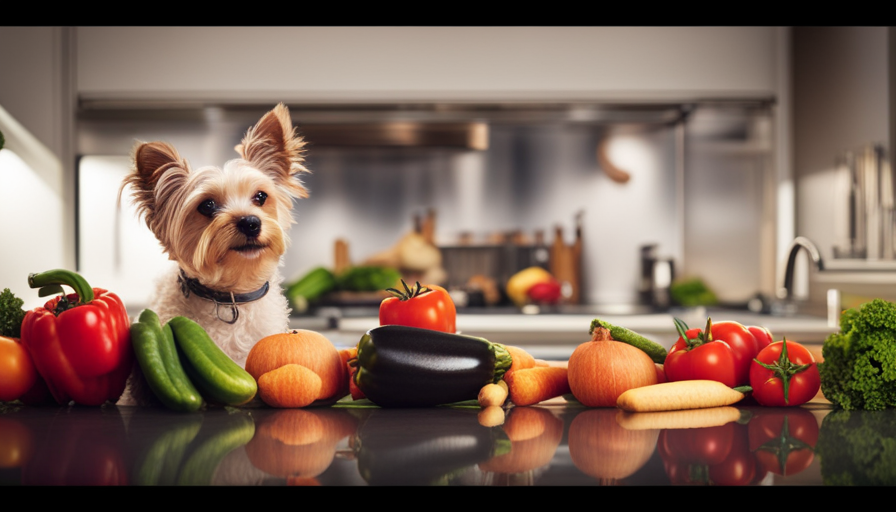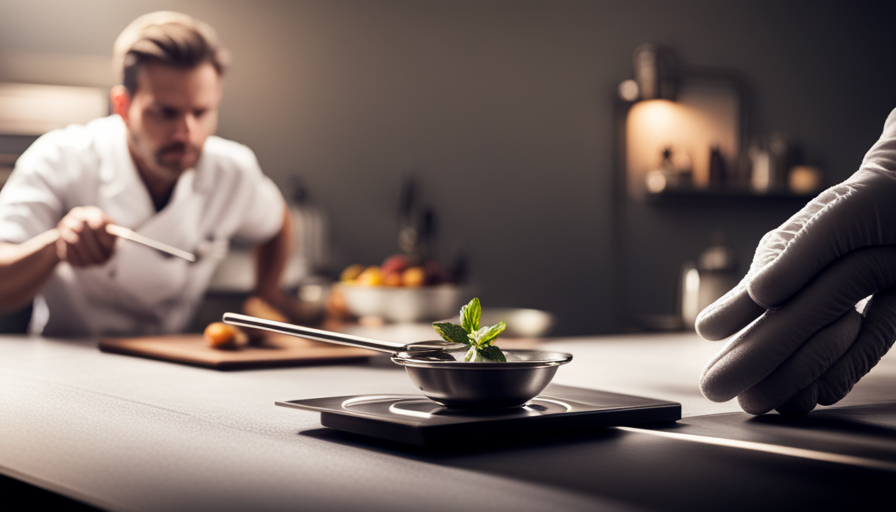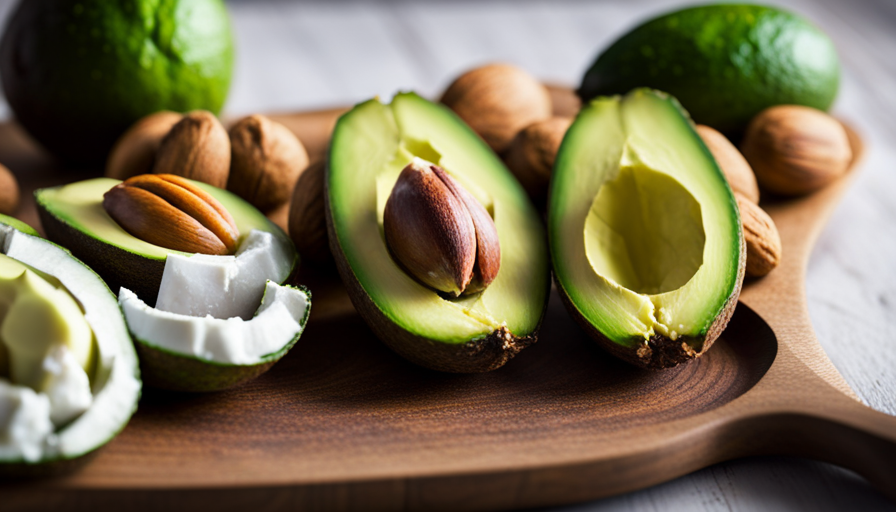Making homemade meals for dogs is like becoming a gourmet chef in our own kitchen, preparing nutritious and delicious meals for our furry friends. Just like a conductor carefully selecting each instrument to create a beautiful melody, we can choose the perfect blend of ingredients to nourish and satisfy our beloved dogs.
In this article, I will guide you through the steps of preparing raw food for your furry friend, ensuring that they receive all the benefits of a natural and balanced diet. From understanding the advantages of raw food to incorporating variety and supplements, we will cover it all. But remember, I am not a veterinarian, so it’s crucial to consult with your trusted professional before embarking on this culinary adventure.
So, grab your apron and let’s dive into the world of raw food preparation for dogs. Together, we will create meals that will not only satisfy their taste buds but also promote their overall health and well-being.
Let’s get cooking!
Key Takeaways
- Gradually transition your dog to a raw food diet, monitoring their weight and overall health throughout the process.
- Consult with a veterinarian to ensure a balanced and nutritionally complete raw food diet that meets your dog’s individual needs and health conditions.
- Handle raw food safely by practicing proper hygiene, including washing your hands before and after handling raw food and keeping it separate from other ingredients.
- Use high-quality ingredients, including a variety of proteins, fruits, vegetables, and grains, to provide essential nutrients and support digestive health.
Understand the Benefits of Raw Food for Dogs
One of the key reasons why raw food is beneficial for dogs is because it enhances their overall health and well-being. When dogs consume raw food, their digestion improves significantly. Raw food is easier for dogs to process, as it contains natural enzymes and beneficial bacteria that aid in breaking down the food. This leads to better absorption of nutrients and ultimately results in improved digestion.
Another benefit of raw food for dogs is healthier skin and coat. Raw food is packed with essential fatty acids, such as omega-3 and omega-6, which are vital for maintaining healthy skin and promoting a shiny coat. These fatty acids help reduce inflammation and itching, preventing common skin issues in dogs.
By feeding your dog a raw food diet, you are providing them with the necessary nutrients for optimal health. However, it’s important to consult with your veterinarian before making any changes to your dog’s diet. They can provide guidance and ensure that your dog’s specific nutritional needs are being met. Transitioning to a raw food diet may require adjustments based on your dog’s age, breed, and any underlying health conditions they may have.
Raw food offers numerous benefits for dogs, including improved digestion and healthier skin and coat. However, it’s crucial to consult with your veterinarian to ensure a smooth transition and to address any specific concerns or requirements your dog may have.
Consult with Your Veterinarian
Before diving into the world of feeding your furry friend a natural diet, it’s crucial to have a conversation with your vet. Consulting with your veterinarian is essential to ensure that raw food is appropriate for your dog’s specific needs and health conditions. They can provide valuable recommendations and guidance on how to properly prepare and balance your dog’s meals.
To help you understand the benefits and risks of feeding raw food, let’s take a look at the following table:
| Vet Recommendations | Raw Food Misconceptions | Benefits of Raw Food |
|---|---|---|
| Discuss your dog’s individual needs and health conditions. | Raw food is dangerous because of bacteria. | Improved digestion and nutrient absorption. |
| Ensure the diet is nutritionally balanced. | Raw food is expensive and time-consuming. | Healthier skin and coat. |
| Gradually transition your dog to a raw diet. | Raw food doesn’t provide all the necessary nutrients. | Increased energy and vitality. |
| Monitor your dog’s weight and overall health. | Raw food can lead to choking or dental issues. | Reduced allergies and food sensitivities. |
| Regularly check for any signs of nutritional deficiencies. | Raw food can cause an unbalanced diet. | Stronger immune system. |
By discussing these points with your vet, you can address any concerns or misconceptions about raw food and make an informed decision for your dog’s diet. Once you have all the necessary information, you can move on to the next section about choosing high-quality ingredients.
Now, let’s talk about how to choose high-quality ingredients for your dog’s raw food.
Choose High-Quality Ingredients
To ensure the best for your furry friend, it’s crucial to select top-notch ingredients for their wholesome diet. When it comes to preparing raw food for dogs, high-quality ingredients are of utmost importance. Here’s why:
-
Nutritional Value: High-quality ingredients provide the necessary nutrients that dogs need to thrive. They’re packed with essential vitamins, minerals, and proteins that support their overall health and well-being.
-
Digestive Health: Dogs have sensitive digestive systems, and feeding them low-quality ingredients can lead to digestive issues. By choosing high-quality ingredients, you can promote better digestion and reduce the risk of gastrointestinal problems.
-
Allergies and Sensitivities: Many dogs have allergies or sensitivities to certain ingredients. Opting for high-quality ingredients can help minimize the risk of triggering allergic reactions or food intolerances.
When sourcing organic ingredients, you can further enhance the quality of your dog’s meals. Organic ingredients are free from pesticides, antibiotics, and growth hormones, making them a healthier choice for your furry friend.
By selecting high-quality ingredients and sourcing organic options, you can ensure that your dog receives the best nutrition possible.
In the next section, we’ll discuss how to prepare balanced meals for your canine companion.
Prepare Balanced Meals
Make sure your furry friend is getting the balanced meals they deserve for optimal health and happiness. When preparing raw food for dogs, it’s essential to create meals that meet all their nutritional needs.
Balanced meal recipes are a great way to ensure that your dog is getting a well-rounded diet. Include a variety of proteins, such as chicken, beef, or fish, along with fruits, vegetables, and grains. To maintain portion control, consider your dog’s size, activity level, and age. Adjust the amounts accordingly to avoid overfeeding or underfeeding.
When preparing balanced meals, it’s important to consider the specific dietary requirements of your dog. For example, if your dog has allergies or sensitivities to certain ingredients, make sure to avoid using them in their meals. Additionally, consult with your veterinarian to determine the appropriate amount of each ingredient to include in the meals.
Follow proper food safety practices to ensure the meals you prepare are safe for your dog to consume. This includes storing raw ingredients separately, washing your hands and utensils thoroughly, and keeping the food refrigerated or frozen until it’s ready to be served.
By following these guidelines, you can provide your furry friend with nutritious and delicious meals that’ll keep them healthy and happy.
Follow Proper Food Safety Practices
Ensure that your precious pooch doesn’t end up in the ER with a case of food poisoning by following proper food safety practices like a responsible pet parent. When handling raw food for your dog, it’s essential to prioritize food safety to prevent any potential illnesses. One crucial aspect of food safety is proper food handling. Always wash your hands before and after handling raw food to avoid the spread of bacteria. Additionally, keep raw food separate from other ingredients and utensils to prevent cross contamination.
To emphasize the importance of this, consider the following table:
| Raw Food | Other Ingredients | |
|---|---|---|
| Utensils | Use separate utensils | Clean utensils thoroughly |
| Storage | Store separately | Keep raw food covered |
By adhering to these practices, you can minimize the risk of harmful bacteria spreading to your dog’s food. Cross contamination can occur when bacteria from raw food comes into contact with cooked or ready-to-eat food, leading to potential health hazards for your furry friend.
As you focus on food safety, it’s crucial to gradually transition your dog to raw food. This will be discussed further in the subsequent section, ensuring a smooth and successful switch to a raw food diet for your canine companion.
Gradually Transition Your Dog to Raw Food
Start by slowly introducing your furry friend to a diet consisting of raw ingredients. The transitioning process is important to ensure that your dog’s digestive system can adjust to the new food.
Begin by mixing a small amount of raw food with your dog’s current diet, gradually increasing the ratio of raw food over time. This gradual transition allows your dog’s body to adapt and prevents any digestive upset.
Transitioning your dog to raw food has numerous benefits. Raw food is packed with essential nutrients and enzymes that can improve your dog’s overall health and well-being. It can help boost their immune system, promote healthy skin and coat, and even reduce allergies. Additionally, raw food can improve your dog’s dental health by naturally cleaning their teeth and gums.
During the transitioning process, it’s important to monitor your dog’s health and adjust as needed. Keep an eye out for any changes in their appetite, energy levels, or stool consistency. If you notice any issues, such as persistent diarrhea or vomiting, it may be necessary to slow down the transition or consult with your veterinarian.
As you move forward in the process of transitioning your dog to raw food, it’s crucial to pay attention to their health and make any necessary adjustments.
Monitor Your Dog’s Health and Adjust as Needed
As you progress in transitioning your furry friend to a raw diet, it’s crucial to attentively observe their well-being and make any necessary adjustments along the way, ensuring their health remains a top priority.
One important aspect to monitor is your dog’s exercise routine. Raw food can provide a boost of energy, so you may notice your dog becoming more active. It’s essential to ensure they’re getting enough exercise to maintain a healthy weight and promote overall well-being. Regular walks, playtime, and engaging activities are all vital for your dog’s physical and mental stimulation.
Additionally, keep an eye on any dietary restrictions your dog may have. Some dogs may have food sensitivities or allergies, and it’s essential to identify and eliminate any ingredients that may cause adverse reactions. Watch for any signs of digestive issues, such as vomiting or diarrhea, as these may indicate a need to adjust the diet. If necessary, consult with a veterinarian or a canine nutritionist to help you tailor the raw food plan to suit your dog’s specific needs.
In the next section on incorporating variety in your dog’s diet, we’ll explore how to introduce different proteins, fruits, and vegetables to provide a well-rounded and nutritious meal plan for your furry companion.
Incorporate Variety in Your Dog’s Diet
To keep your furry friend excited about mealtime, mix up their menu with a diverse range of protein sources, fruits, and vegetables. Variety benefits your dog in several ways. Firstly, it prevents them from getting bored with their food, ensuring they stay interested and eager to eat. Secondly, it provides a wider range of nutrients, helping to maintain their overall health and wellbeing. By incorporating different protein sources such as chicken, beef, fish, and lamb, you can ensure your dog receives a balanced array of essential amino acids. Additionally, including a variety of fruits and vegetables like blueberries, carrots, and spinach adds valuable vitamins and minerals to their diet.
To help you understand the importance of variety, take a look at the table below:
| Protein Sources | Fruits | Vegetables |
|---|---|---|
| Chicken | Apples | Carrots |
| Beef | Berries | Spinach |
| Fish | Oranges | Broccoli |
| Lamb | Bananas | Sweet Potato |
By including different options from each column, you can create endless combinations that provide both taste and nutritional balance for your furry companion.
Incorporating variety in your dog’s diet is crucial for their overall health. It ensures they receive a wide range of nutrients while keeping them excited about mealtime. In the next section, we will discuss how to supplement as necessary to address any specific dietary needs.
Supplement as Necessary
When it comes to supplementing your dog’s diet, there are a few key points to consider. First, adding omega-3 fatty acids can provide numerous benefits for your dog’s overall health. These benefits include improving skin and coat condition, reducing inflammation, and supporting brain function.
Second, including probiotics and digestive enzymes can help promote a healthy gut microbiome. They also aid in digestion and support a strong immune system.
Lastly, it’s important to consult with your veterinarian to determine the appropriate dosage and type of supplements for your dog’s specific needs.
Adding Omega-3 Fatty Acids
By incorporating omega-3 fatty acids into your dog’s raw food, you’ll be unlocking the key to their vibrant health and well-being. Omega-3 fatty acids are essential for dogs as they provide numerous benefits, including improved joint health, reduced inflammation, and enhanced cognitive function.
When it comes to sources of omega-3, you have a few options. The most common source is fish oil, which is rich in EPA and DHA. Other sources include flaxseed oil and chia seeds, although they contain ALA, which needs to be converted by the body.
The recommended dosage of omega-3 fatty acids for dogs is around 1000mg per 10 pounds of body weight. Remember to consult with your veterinarian to determine the ideal dosage for your furry friend.
Now, let’s delve into the next section about including probiotics and digestive enzymes.
Including Probiotics and Digestive Enzymes
Including probiotics and digestive enzymes in your dog’s diet can create a harmonious balance in their gut, like a symphony of beneficial bacteria and enzymes working together for optimal digestion and nutrient absorption. Probiotics are live bacteria that provide numerous benefits to your dog’s digestive system. They help maintain a healthy balance of good bacteria, improve nutrient absorption, and support a strong immune system. Some common probiotic options for dogs include species such as Lactobacillus and Bifidobacterium. On the other hand, digestive enzymes help break down food into smaller, more easily digestible molecules. They can be especially beneficial for dogs with digestive issues or those on a raw food diet. Options for digestive enzymes include bromelain, papain, and pancreatin. By including these supplements in your dog’s diet, you can support their digestive health and overall well-being. Now, let’s explore how to stay informed and educated about raw food preparation for dogs.
Stay Informed and Educated
Make sure you stay informed and educated about the proper ways to prepare raw food for your furry friend. It’s essential to do your research and gather information from reliable resources.
By staying informed, you can ensure that you’re providing your dog with a balanced and nutritious diet. One way to stay educated is by researching different raw food recipes and meal plans. There are numerous online resources, books, and forums dedicated to raw feeding. These sources can provide you with valuable information on ingredient selection, portion sizes, and the overall nutritional needs of your dog.
Additionally, it’s important to understand the potential risks and benefits associated with raw feeding. While there are many proponents of raw diets, there are also concerns about bacterial contamination and nutrient imbalances. Staying informed allows you to make well-informed decisions based on your dog’s individual needs and health conditions.
Remember, the world of raw feeding is constantly evolving, and new research and information are continually emerging. By staying educated, you can adapt your dog’s diet as needed and provide them with the best possible nutrition. So, take the time to stay informed, do your research, and consult with professionals if needed. Your furry friend will thank you for it.
Frequently Asked Questions
How do I know if my dog is ready to transition to a raw food diet?
When it comes to transitioning a dog to a raw food diet, there are a few signs that indicate they may be ready for the switch. Look out for improved digestion, increased energy levels, shinier coat, and healthier teeth and gums. If your dog is showing these signs, it may be a good time to start introducing raw food into their diet.
However, it’s important to consult with your veterinarian before making any major dietary changes for your furry friend.
Can I feed my dog solely on raw food or should I still include some kibble in their diet?
I recommend feeding dogs solely on a raw food diet for optimal health and nutrition. While kibble may seem convenient, it lacks the benefits of a raw food diet for dogs. Raw food provides essential nutrients, enzymes, and a natural balance of proteins, fats, and carbohydrates. It promotes better digestion, healthier skin and coat, increased energy levels, and stronger immune systems. Transitioning to a raw food diet can greatly improve your dog’s overall well-being.
Are there any specific ingredients that I should avoid when preparing raw food for my dog?
When preparing raw food for my dog, it’s important to avoid certain ingredients that can be harmful to their health. Common mistakes include using onions, garlic, or grapes, which can be toxic to dogs. Additionally, I steer clear of seasoning with salt or using excessive amounts of fatty meats.
It’s crucial to research and consult with a veterinarian to ensure I’m providing a well-balanced and safe raw diet for my furry friend.
How often should I change the protein source in my dog’s raw food diet?
I recommend changing the protein source in my dog’s raw food diet every few weeks to ensure a varied diet. This helps prevent my dog from developing any allergies or sensitivities to a specific protein source.
Additionally, a varied diet provides a wide range of nutrients that are essential for my dog’s overall health and well-being. Incorporating different protein sources such as chicken, beef, and fish also adds variety to my dog’s meals, making them more enjoyable.
Is it safe to feed my dog raw bones as part of their raw food diet?
Yes, it’s generally safe to feed your dog raw bones as part of their raw food diet. Raw bones provide several benefits for dogs, including dental health and mental stimulation. However, it’s important to choose appropriate bones for your dog’s size and breed, and always supervise them while they’re chewing. If you’re concerned about the safety of raw bones, there are alternative options, such as raw meaty bones or recreational bones that are designed for chewing rather than consumption.
What Are the Best Raw Food Options for Introducing to a Dog?
When introducing raw food to dogs, it’s important to start with easily digestible options like raw eggs, boneless meats, and vegetables. Avoid foods like grapes, onions, and garlic. Gradually incorporate new items and monitor your dog’s response to find the best raw food options for their diet.
Conclusion
In conclusion, preparing raw food for dogs is a rewarding and fulfilling experience. By understanding the benefits of raw food, consulting with your veterinarian, and choosing high-quality ingredients, you can ensure that your furry friend receives the best nutrition possible.
By following proper food safety practices, monitoring your dog’s health, and incorporating variety in their diet, you can keep them happy and healthy. Remember to supplement as necessary and stay informed and educated about their dietary needs.
So why wait? Start preparing raw food for your dog today and see the incredible difference it makes in their overall well-being.










